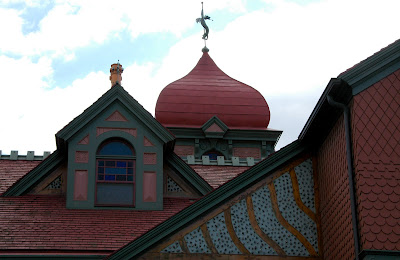In many ways, the ten months I spent in Monterey were intense. I had never been to California before; everything about it was a source of wonder for me:
- The food was different - peanut butter and sprouts on a bagel? Artichokes on a pizza? Since I've always been a picky eater, it was amazing that I tried these and liked them!
- The land was different - stepping out of the barracks in the morning, I could look down the hill to see Monterey Bay or over at the snow-covered peak of a neighboring mountain (hill?).
- The weather was different - every afternoon a fog rolled over the hilltop from Pacific Grove (which is why we called it the PG Monster). We could set our watches by its appearance.
My classmates and I spent six hours a day, Monday through Friday, learning Russian and the rest of the time running around Monterey. We went to movies at the Dream Theater, where there was a variety of seats to choose from - recliners, regular movie seats, tables and chairs - how novel!!! (This is where I saw the first Star Wars movie in 1977.) We spent time on Cannery Row exploring all the cool shops that offered tourists crystals and unique crafty stuff. We visited the Coast Guard pier and marveled over the gazillions of barking sea lions on the rocks. (This is probably where I saw my first live starfishes.) We ate Saturday lunches at the Viennese Pastry Shop on Alvarado Street and walked to Campagno's for yummy sandwiches to eat on the monument to Commodore Sloat. (Yes, we actually climbed up on the monument - the view of the bay was magnificent!) And sometimes, we'd hitch a ride with a fellow student over to Asilomar or Carmel. Such a life! For years after leaving Monterey, I ached to go back. I dreamed at night of Big Sur and Monterey's Fisherman's Wharf.
I have returned to Monterey a couple of times. Last Sunday, upon flying in to San Francisco for a two-day Magnet workshop, I rented a car and drove down - through a subtropical storm (the mist in the redwoods was both beautiful and eerie) - to visit my old haunts.
Of course, neither of us (Monterey and I) is the same as we were in 1977. A beautiful aquarium now sits at the end of Cannery Row, and several hotels have moved in to block the view of the bay in some spots. The Viennese Pastry Shop is gone and the Dream Theater is now a store. And the Presidio of Monterey is now off limits to non-military folks. Since I'm no longer military, I was turned back at each of the gates I tried. Sniff sniff.
Some things have stayed the same, however. Compagno's is still open at the corner of Prescott and Taylor, even though it does look pretty run down. The Pacific still pounds Asilomar, fascinating tourists and locals alike as they hunt for interesting stuff left in the rocks by the retreating waves. The sea lions still lounge on the rocks by the Coast Guard pier between meals.



The Monterey Canning Company is still filled with touristy shops at the corner of Prescott and Cannery Row.
Now, being older, I could afford a car to drive up the Prescott Street hill. Back in 1977, walking back up the steep incline to post from Cannery Row would just about kill me.
Over in Pacific Grove, I saw the Monterey sea lions' cousins lazing away out in the water...

...and enjoyed the view of Monterey from the path by the water in Pacific Grove.

Here's looking west from the path. The skies and light were yucky, but at least it wasn't pouring rain!!!

So after spending a couple hours driving around, I'd had my Monterey fix for the decade. I drove back to San Francisco along the coastal road. The area north of Santa Cruz is much more rural and wonderful than the stretch further south; I snatched quick glimpses of the waves crashing on the rocks down below and was reminded yet again what makes California so special to me (besides Monterey and the food and the cities' cultural diversity and Arnie, of course). The natural environment is just spectacular! And on this dreary, drizzly day, I was especially thankful that someone - the state government, whoever - had had the foresight to protect this particular bit of fabulous landscape from development, so that people like me could enjoy it.
After this, the workshop was anti-climactic. I did get a chuckle out of the young security guard at the San Francisco airport calling me "young lady", however. Perhaps I haven't changed that much after all... :)






















